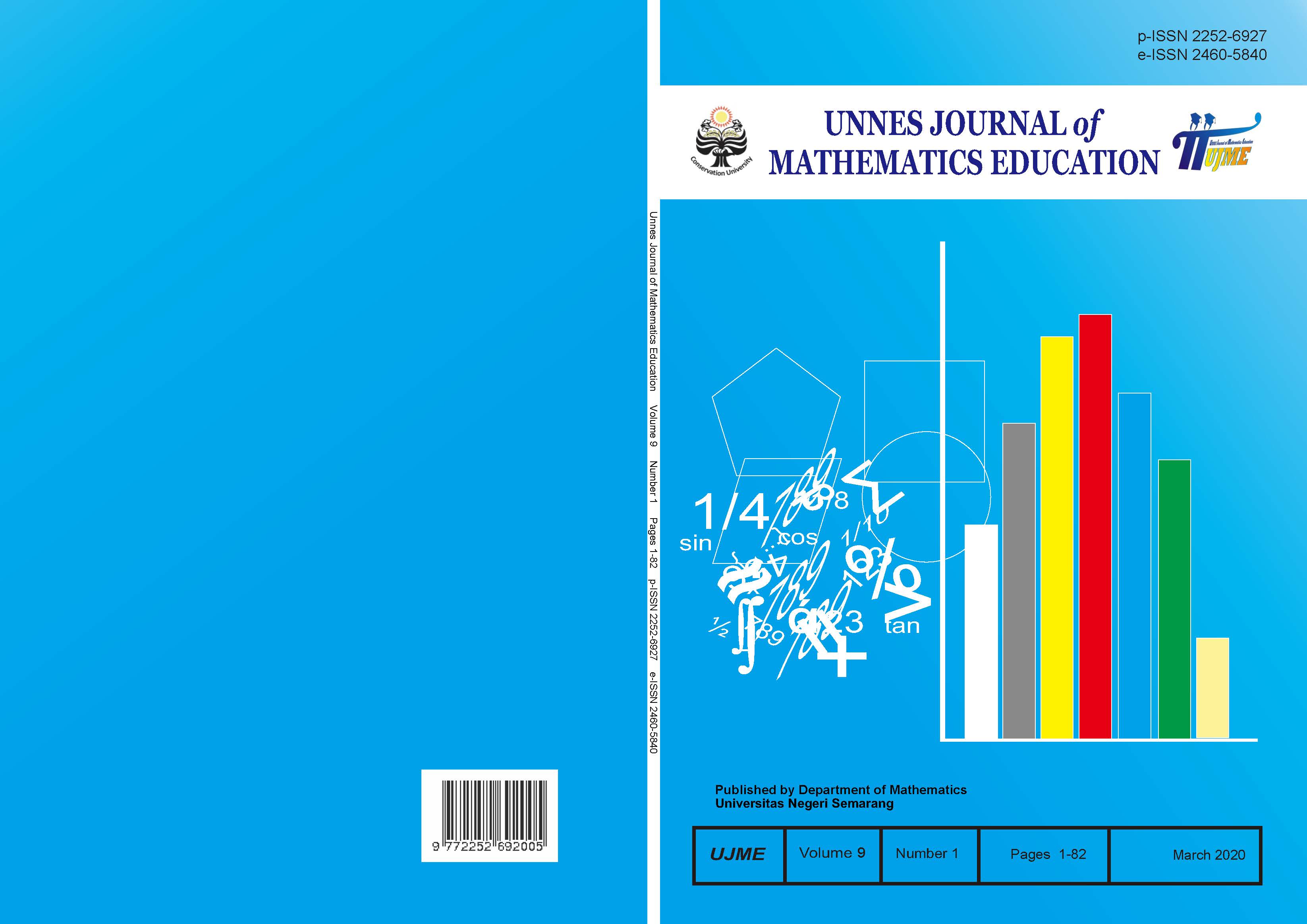Mathematical creative thinking skills of eight grade in terms of learning styles on learning model Means-Ends Analysis (MEA)
##plugins.themes.academic_pro.article.main##
Abstract
This study aims to test whether learning with the Means-Ends Analysis (MEA) model achieves learning completeness and knows the description of the ability to think creative with the MEA model in terms of student leraning styles. Research is a research mixed methods model of concurrent triangulation. The population of this research is students of class VIII one of Junior High School in Pekalongan in the academic year 2018/2019, a sample of students of class VIII-F. Research subjects were students of class VIII-F selected with purposive sampling technique, selected 4 students from the type of visual and auditory learning styles, and 3 students from the type of kinesthetic learning style. Quantitative data were analyzed using the one-party average test and the one-party proportion test. Whereas qualitative data were analyzed using the Miles adnd Huberman model, namely making verbal data transcripts, data reduction, data analysis, and making conclusions. The result showed that: (1) learning with the MEA model achieved mastery learning; and (2) description of creative thinking abilities of students with models of MEA in terms of students learning styles that students with visual learning style meet three indicators of creative thinking that fluency fluency, originality, and elaboration; students with learning styles of auditory almost all meet the four indicators of creative thinking that fluency, flexibility, originality, and elaboration; students with kinesthetic learning style meets the four indicators of creative thinking that fluency, flexibility, originality, and elaboration.
##plugins.themes.academic_pro.article.details##
References
Subur, J. 2013. “Analisis Kreativitas Siswa dalam Memecahkan Masalah Matematika Berdasarkan Tingkat Kemampuan Matematika di Kelasâ€. Jurnal Penelitian Pendidikan, 14(1): 49-54.
Kadir & La Masi. 2014. Mathematical Creative Thinking Skills Of Student Junior High School In Kendari City. Prosiding1st International Seminar on Innovation in Mathematics and Mathematics Education. Yogyakarta: Universitas Negeri Yogyakarta.
Kurniasih, A.W., 2012. “Scaffolding sebagai Alternatif Upaya Meningkatkan Kemampuan Berpikir Kritis Matematikaâ€. Jurnal Kreano, 5(2): 113-124.
Mullis, I.V.S., M.O. Martin, P. Foy, & A. Arora. 2012. TIMSS 2011 international Result in Mathematics. USA: TIMSS & PIRLS International Study Center.
Armada, T.S. 2012. Pengaruh Model Pembelajaran Means-Ends Analysis (MEA) Terhadap Hasil Belajar Matematika Pada Siswa Kelas V SD Gugus V Kecamatan Sukasada. Artikel. Universitas Pendidikan Ganesha. Singaraja: Undiksha
Sari, Y. N. 2018. “Pengaruh Penerapan Model Pembelajaran Means Ends Analysis Menggunakan Media Video Terhadap Keaktifan Belajar Peserta Didik Pada Mata Pelajaran Ekonomi Di SMA Negeri 3 Pagar Alamâ€. Jurnal Profit, 5(1): 89-104.
Umar, W. 2017. “Constructing Means Ends Analysis Instruction to Improve Students’ Critical Thinking Ability and Mathematical Habits of Mind Dispositionsâ€. International Journal of Education and Research, 5(2): 261-272.
Gunawan, A. 2012. Genius Learning Strategy: Petunjuk Praktis untuk Menerapkan Accelarated Learning. Jakarta: Gramedia.
Chatib, M. 2014. Orangtuanya Manusia: Melejitkan Potensi Kecerdasan dengan Nyaman dan Menyenangkan. Bandung: Kaifa.
Triwibowo, Z., Dwidayati, N. K., Sugiman. 2017. “Analisis Kemampuan Berpikir Kreatif Matematis Ditinjau dari Gaya Belajar Siswa Kelas VII Melalui Model Pembelajaran Treffinger dengan pendekatan Open-Endedâ€. Unnes Journal of Mathematics education, 6(3): 391-399.
Sari, A. K. 2014. “Analisis Karakteristik Gaya Belajar VAK (Visual, Auditorial, Kinestetik) Mahasiswa Pendidikan Informatika Angkatan 2014. Jurnal Ilmiah Edutic, 1(1). ISSN 2407-4489.
Siswono. 2007. Penjenjangan Kemampuan Berpikir Kreatif dan Identifikasi Berpikir Kreatif Siswa Dalam Memecahkan dan Mengajukan Masalah Matematika. Disertasi. Tidak dipublikasikan. PPS UNESA Surabaya.
